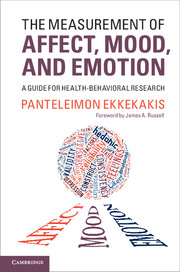Book contents
- Frontmatter
- Contents
- Figures
- Foreword
- Prologue
- 1 Documenting the breadth and depth of the problem
- 2 Untangling the terminological Gordian knot
- 3 Should affective states be considered as distinct entities or as positioned along dimensions?
- 4 Are pleasant and unpleasant states independent or polar opposites?
- 5 Selecting a measure
- 6 The old classics
- 7 Dimensional measures
- 8 Domain-specific measurement
- 9 Problems of domain specificity
- Epilogue
- References
- Index
Foreword
Published online by Cambridge University Press: 05 March 2013
- Frontmatter
- Contents
- Figures
- Foreword
- Prologue
- 1 Documenting the breadth and depth of the problem
- 2 Untangling the terminological Gordian knot
- 3 Should affective states be considered as distinct entities or as positioned along dimensions?
- 4 Are pleasant and unpleasant states independent or polar opposites?
- 5 Selecting a measure
- 6 The old classics
- 7 Dimensional measures
- 8 Domain-specific measurement
- 9 Problems of domain specificity
- Epilogue
- References
- Index
Summary
Emotions, moods, passions, feelings, and other affectively charged states are now recognized as essential in the human condition. With the fading of behaviorism and then cognitivism a generation ago, emotions and the rest won their rightful status within the human sciences as a legitimate topic. It’s fair to ask how the field of affective science is doing.
Panteleimon Ekkekakis provides a frank, sobering, and unfortunately accurate answer: the basic building blocks of science – clearly defined concepts and valid tools to measure them – are missing from much of the research. Ekkekakis focuses on health research, but his diagnosis applies as well to any branch of human science, including education, social welfare, and psychology in general. Fortunately, he also provides a much needed practical remedy.
Progress in affective science has been slow – as if our party won the election but then failed to form a new government. The explanation for the slow progress may be that science is not simply the accumulation of facts. Creation of a new science is not a transition from a blank slate to a scientific paradigm, but from one paradigm to another. The initial pre-scientific paradigm is the set of everyday, lay folk concepts and assumptions. We inherit concepts from angst to zeal with the preconceptions that accompany them. Astronomy, physics, and biology all show how difficult this transition is and how qualitatively different the initial folk concepts typically are from later scientific ones.
The affective domain is heterogeneous. The everyday concept of emotion is too heterogeneous, for it includes object-directed states (such as loving someone) and object-free or free-floating ones (such as malaise or anxiety) and includes long-term states (such as loving someone) and short-term ones (such as startle). To assess an emotional episode, one must therefore consider its object and its
- Type
- Chapter
- Information
- The Measurement of Affect, Mood, and EmotionA Guide for Health-Behavioral Research, pp. xii - xiiiPublisher: Cambridge University PressPrint publication year: 2013



